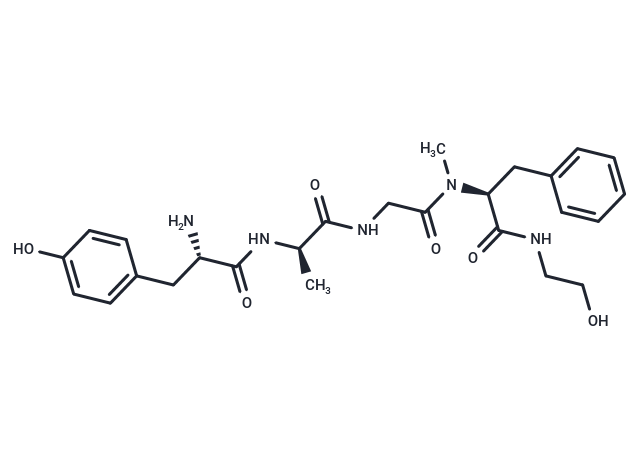Shopping Cart
- Remove All
 Your shopping cart is currently empty
Your shopping cart is currently empty
DAMGO (DAGO) is an opioid receptor agonist with the ability to affect the locomotive activity in rodents. Possible analgesic agent due to μ-opiod receptor interaction.

| Pack Size | Price | Availability | Quantity |
|---|---|---|---|
| 1 mg | $43 | In Stock | |
| 2 mg | $55 | In Stock | |
| 5 mg | $79 | In Stock | |
| 10 mg | $143 | In Stock | |
| 25 mg | $297 | In Stock | |
| 50 mg | $445 | In Stock | |
| 100 mg | $656 | In Stock | |
| 1 mL x 10 mM (in DMSO) | $90 | In Stock |
| Description | DAMGO (DAGO) is an opioid receptor agonist with the ability to affect the locomotive activity in rodents. Possible analgesic agent due to μ-opiod receptor interaction. |
| Targets&IC50 | μ opioid receptor (Native):3.46±0.84 nM (Kd) |
| In vivo | (1) DAMGO inhibits GABAergic inputs in VTA-DA neurons at presynaptic sites; (2) effect of DAMGO on GABAergic inputs in VTA-DA neurons is inhibited by potassium channel blocker 4-aminopyridine (4-AP) and Gi protein inhibitor N-ethyl maleimide (NEM); (3) phospholipase A2 (PLA2) does not mediate the effect of DAMGO on GABAergic inputs in VTA-DA neurons, but mediates it in the periaqueductal gray (PAG); (4) multiple downstream signaling molecules of l receptors do not mediate the effect of DAMGO on GABAergic inputs in VTA-DA neurons. These results suggest that DAMGO depresses inhibitory synaptic transmission via l receptor-Gi protein-Kv channel pathway in VTA-DA neurons, but via l receptor-PLA2 pathway in PAG |
| Synonyms | RX-783006, Dagol, DAGO |
| Molecular Weight | 513.59 |
| Formula | C26H35N5O6 |
| Cas No. | 78123-71-4 |
| Smiles | C[C@@H](NC(=O)[C@@H](N)Cc1ccc(O)cc1)C(=O)NCC(=O)N(C)[C@@H](Cc1ccccc1)C(=O)NCCO |
| Relative Density. | 1.271g/cm3 |
| Color | White |
| Appearance | Solid |
| Sequence | Tyr-{d-Ala}-Gly-{Me-Phe}-Gly-ol |
| Sequence Short | Y-{d-Ala}-G-{Me-Phe}-G-ol |
| Storage | store at low temperature,keep away from moisture | Powder: -20°C for 3 years | In solvent: -80°C for 1 year | Shipping with blue ice/Shipping at ambient temperature. | ||||||||||||||||||||||||||||||
| Solubility Information | DMSO: 33.33 mg/mL (64.90 mM), Sonication is recommended. | ||||||||||||||||||||||||||||||
Solution Preparation Table | |||||||||||||||||||||||||||||||
DMSO
| |||||||||||||||||||||||||||||||

Copyright © 2015-2025 TargetMol Chemicals Inc. All Rights Reserved.